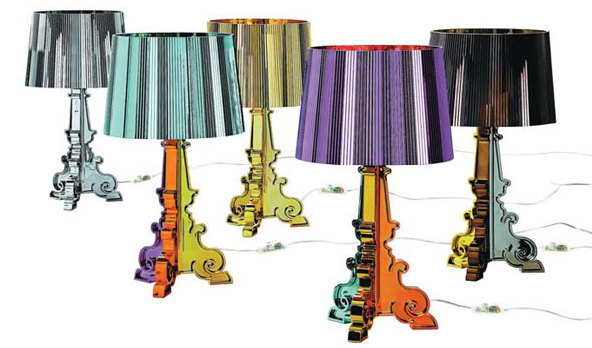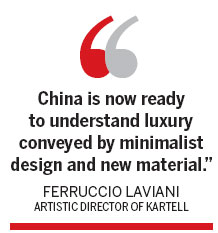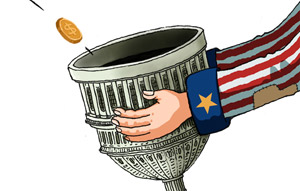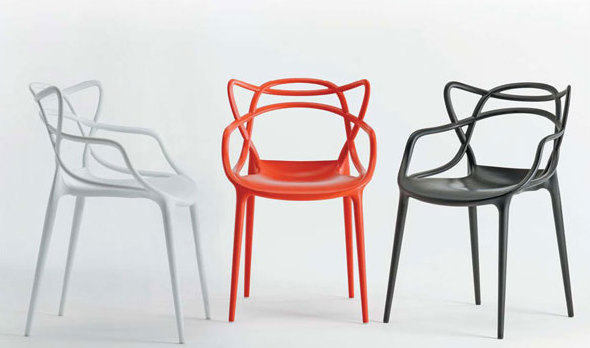Luxury dresses in plastic
Updated: 2013-07-17 07:11
By Sun Yuanqing (China Daily)
|
||||||||
|
Kartell introduces its ultramodern furniture, such as the Masters Chair and Bourgie Lamp, to the Chinese market. Photos provided to China Daily |

Kartell, an Italian brand known for its designer plastic furniture, has opened its first store in the Chinese mainland. Sun Yuanqing finds out more about the uniqueness of the new material.
Ultramodern plastic furniture looks cool in The Devil Wears Prada and Boston Legal, but how would they match with heavy wooden Chinese cabinets?
While most Chinese homes still prefer age-old furniture made from precious wood, some are going for a modern twist.
"China is now ready to understand luxury conveyed by minimalist design and new material, also to understand the difference between originals and copies. We are here to make them understand our philosophy and the world of industrial design," says Ferruccio Laviani, artistic director for Kartell, an Italian brand known for its designer plastic furniture.
"What we do is to make complements. You can take a transparent polycarbonate plastic chair and put it alongside an old piece of furniture handed down from the family. This would make a more interesting and personal style," he says.
Kartell opened its first mainland boutique in Beijing in late May.
"In the past, when we flew to Asia, it was more about Hong Kong and Singapore. But China (the mainland) has been a more interesting destination lately," he adds.
With more than 130 flagship stores and 220 in-store shops around the globe, Kartell is planning to open 50 stores in China within five years. Two will be opened in Shanghai and one in Chengdu, Sichuan province, later this year.
Aside from a handful of Western movies and television series, Kartell's designs have also appeared in a popular Chinese movie Go Lala Go!
Just as he believes that a furniture collection mirrors the characteristics of the owner, Laviani also advocates impromptu in the usage of furniture.
"For example, a bench could be used for sitting, as well as a table. It's up to you how to use it."

Kartell could be a role model for Chinese home designers, said Steve Leung, Hong Kong-based architect and interior designer, as he attended the opening ceremony of the Beijing store.
"The way they use plastic to make unique modern furniture is very refreshing and prospective. There are so many opportunities coming out of the new techniques and materials that Chinese home designers can explore, just like Kartell did," Leung says.
Unlike in Milan, New York and Paris, Laviani employs a more glamorous layout and lighting in the Beijing showroom to help people understand the value of the products.
"We try to emphasize every object. For people who are not used to this kind of design, we try to explore a new way to explain to them."
Born in Cremona, Italy, in 1960, Laviani studied at the Design Polytechnic of Milan and later obtained a degree in architecture at the Polytechnic of Milan in 1986. He has since been working as an architect and designer.
Laviani was in China several times to design the stores for Dolce & Gabbana in Beijing and Shanghai, as well as for Flos Spa in Hangzhou and Hong Kong. All these different jobs inspire him in different aspects, he says.
Originally a minimalist, Laviani has become more attracted to baroque styles since his cooperation with Dolce & Gabbana 13 years ago.
"At the time, I always hated gold as a finishing on furniture. I thought it was quite vogue. I didn't use it also because I was scared to use it, because I thought I wasn't able to use it in the right way."
With the cooperation with Dolce & Gabbana, Laviani finally "learned the right way to use gold". He then made the signature Kartell Bourgie Lamp with a gold finish, which later became one of the company's best sellers, along with the iconic transparent Louis Ghost chair by Philippe Starck.
For Laviani, inspiration comes from everywhere except design itself.
"When I'm at home, the last thing that I want to see is design newspaper and blogs. Neither do I like talking about design with my friends, who can be doctors and lawyers. Talking with different people about different things gives me inspirations for my job."
Having been designing for nearly three decades, Laviani is looking for new challenges that he has never faced before.
"I already designed everything that I like. What I need now is to have somebody to come to me and offer something that I never did before, something that allows me to use my brain in different ways.
"I don't like it when people call just because they want something signed by me but they don't understand my possibility. It's frustrating that they just want you in their catalog, but in reality they don't appreciate the things you do. For me, designing a suitcase could be more interesting than designing an airplane."
Contact the writer at sunyuanqing@chinadaily.com.cn.
(China Daily 07/17/2013 page19)

 Victoria Beckham S/S 2014 presented during NYFW
Victoria Beckham S/S 2014 presented during NYFW
 'Despicable' minions upset Depp's 'Lone Ranger' at box office
'Despicable' minions upset Depp's 'Lone Ranger' at box office
 'Taken 2' grabs movie box office crown
'Taken 2' grabs movie box office crown
 Rihanna's 'Diamonds' tops UK pop chart
Rihanna's 'Diamonds' tops UK pop chart
 Fans get look at vintage Rolling Stones
Fans get look at vintage Rolling Stones
 Celebrities attend Power of Women event
Celebrities attend Power of Women event
 Ang Lee breaks 'every rule' to make unlikely new Life of Pi film
Ang Lee breaks 'every rule' to make unlikely new Life of Pi film
 Rihanna almost thrown out of nightclub
Rihanna almost thrown out of nightclub
Most Viewed
Editor's Picks

|

|

|

|

|

|
Today's Top News
Going green can make good money sense
Senate leader 'confident' fiscal crisis can be averted
China's Sept CPI rose 3.1%
No new findings over Arafat's death: official
Detained US citizen dies in Egypt
Investment week kicks off in Dallas
Chinese firm joins UK airport enterprise
Trending news across China
US Weekly

|

|








